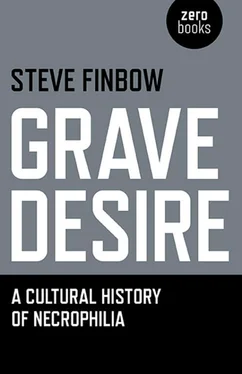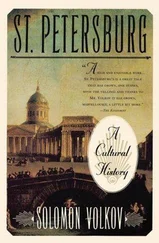There is also a question of power and possession, the body relegated to that of sexual slave and passive object used and abused, fucked and discarded—an element of role playing and sadomasochism, not wholly connected with necrophilia—but taken to its extreme, it results in lust murderers like Dennis Nilsen and Gary Ridgway. Conversely, lack of control may ignite violence and result in the passive victim enacting revenge: as in the case of a 16-year-old student who killed his mother after years of forced incest and then anally and vaginally raped her dead body. Fear of castration, an ongoing infantile sexuality, narcissism, and the Oedipus complex have all been cited as factors in the psychology of necrophiles and so have mourning, obsessive love, opportunism and rejection by a partner. No single cause creates a necrophile. All of the above may contribute to a desire to have sex with dead bodies—Bertrand himself was a narcissist with a possible Oedipal complex who may have suffered head trauma and hallucinations. If this is the case, then how widespread is necrophilia? Aggrwaal provides an epidemiological overview. [55] See Chapter 2, Necrophilia: Forensic and Medico-Legal Aspects.
As the aetiology of necrophilia shows, the contributing factors that cause a sexual desire for the dead could also create other paraphilias, or none at all. As Aggrawal points out, necrophilia is possibly the most secret of acts with the partner/victim forever silent. Is necrophilia more widespread than reports and studies show? As necrophilia was not until recently considered a crime, then the lack of reporting on the subject is understandable—it can be argued that it is a victimless crime, but then one could argue that it is a crime against property if the family or religious denomination claim the body as their own. Aggrawal uses Rosman and Resnick’s ‘Sexual attraction to corpses: a psychiatric review of necrophilia’ [56] ‘Sexual attraction to corpses: a psychiatric review of necrophilia’, Bull. Am Acad. Psychiatry Law. 1989; 17 (2), pp. 153–163.
as the basis of an epidemiology and as character analysis. Out of a study of 122 necrophiles, they found an age range from 16 to 65—a normal range for sexually active men and women of all persuasions. 95% of these were men, 14 of whom had committed murder for necrophiliac purposes. Intelligence levels across the group ranged from signs of insanity to those with a high IQ (the means of assessment). Heterosexuality, bisexuality, and homosexuality in necrophiles corresponded to statistical evidence in society. Alcohol and drug use may contribute to necrophiliac acts, however Rosman and Resnick’s analysis failed to find evidence in the reports they analyzed. Sex of corpse—10% of necrophiles chose same-sex corpses, this statistic was higher—50%—among necrophiliac killers. Marital status—60% single, 26% married, and 14% divorced or widowed. A large percentage of all necrophiles showed a prior tendency towards sadism and cruelty. The survey found no evidence that psychotics, people suffering personality disorders, or having unusual belief systems, made up a large proportion of the group. Occupation—although Rosman and Resnick found evidence that hospital orderlies, cemetery employees, morgue attendants, funeral parlour assistants, soldiers, clerics, pathologists, anatomy students, ambulance drivers, and volunteer firemen had all been found to have a predilection for sex with corpses it was not stated whether the necrophilia was a result of opportunity—all professions having access to corpses—or that the person had manoeuvred themself into a job in which they had access to the objects of their desire. [57] See: Chapter 4, Necrophilia: Forensic and Medico-Legal Aspects.
Helpful as the aetiology and epidemiology are, neither provides any firm conclusions as to the cause or profusion of necrophilia in history and society. ‘He needs to do it so much and knows that he can’t live without it—and in any event, no matter how hard he tries, he’s already done it and there can never be any real peace or any hope of forgiveness. His life is tainted and he can’t go back. [58] Straw Men, p. 208.
3
NecroHysteria—A Short History
Describing Egyptian embalming methods in The History, circa 440 BCE, Herodotus writes, ‘The wives of distinguished men, when they die, they do not give for embalmment right away, nor yet women who are especially beautiful and of great account. Only when they have been dead three or four days do they hand them over to the embalmers. This is done to prevent the embalmers from copulating with these women. For they say that one of them was caught copulating with a freshly dead woman and that a fellow workman told on him.’ [59] Herodotus, The History, trans. David Greene (Chicago, 1987) p. 167.
In the 1940s, Ed Gein would wait at least three or four days before disinterring a woman’s corpse (or part of) for whatever sexual purpose he had in mind. 2,500 years before Gein’s crimes were unearthed, Herodotus describes the prevalence of similar taboos of necrophilia in Ancient Egypt.
There are necrophiles who only experience full sexual satisfaction from having sex with a dead body, and there are those that copulate with corpses because of their availability and the unavailability (or impossibility) of having sex with a living person. Is it a freedom of sexual choice or a weakness and failing of the super-ego? From the time of the pre-Socratic philosopher Empedocles (490-430 BCE), who ‘kept a woman alive for thirty days without breath or pulse,’ [60] Simon Critchley, The Book of Dead Philosophers (London, 2008), p. 16.
to the library of books on serial killers and sex murderers, writers and historians have been fascinated with necrophiles and necrophilia. ‘Before I began killing boys, and afterward when I couldn’t find one or hadn’t the energy to go looking, there was another thing I would sometimes do. It began as a crude masturbation technique and ended very near mysticism. At the trial they called me necrophiliac without considering the ancient roots of the word, or its profound resonance. I was friend of the dead, lover of the dead. And I was my own first friend and lover.’ [61] Poppy Z. Brite, Exquisite corpse (London, 1996), p. 15.
If ‘[d]eath is the last great taboo,’ if ‘[w]e cannot look it in the face for fear of seeing the skull beneath the skin,’ [62] The Book of Dead Philosophers, p. 279.
surely having sex with a dead body, penetrating that skull beneath the deliquescing flesh, is the greater taboo, and the one from which to begin to philosophize about the human condition. Referring back to Herodotus and forward 2,000 years to Montaigne’s moral epigram formulated from his thoughts on Egyptian death rites in which he states he has ‘formed the habit of having death continually present, not merely in my imagination, but in my mouth,’ [63] The Book of Dead Philosophers, p. xii.
then the occurrence of necrophilia among Egyptian embalmers through to the likes of Ed Gein, Ted Bundy, and Jeffrey Dahmer shows that death and the love of the dead is not merely a myth, not part of our dark imaginings, but part of human culture, continually present, a parallel world in which love turns into pathological obsession and a close proximity to death becomes a perversion. ‘Then he turned to the girl. He took off all her clothes and looked at her, inspecting her body carefully, as if he would see how she were made. He went outside and looked in through the window at her lying naked before the fire. When he came back in he unbuckled his trousers and stepped out of them and laid next to her. He pulled the blanket over them.’ [64] Cormac McCarthy, Child of God (London, 2010), p. 87.
Читать дальше












